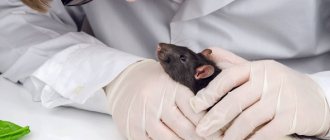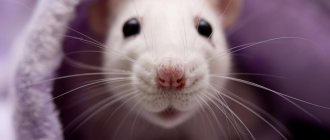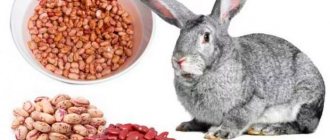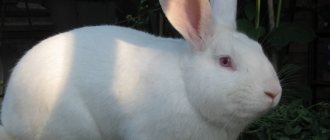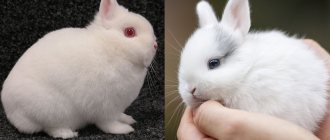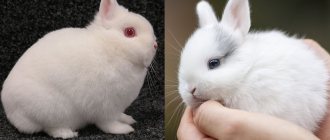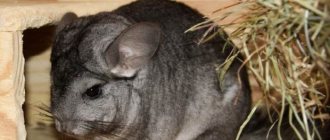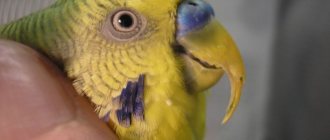- Iodide mixtures
Coccidiosis in rabbits is ubiquitous and is a dangerous invasive disease that leads to severe damage to the intestines and liver of animals. Its causative agents are protozoan unicellular parasites of the coccidia class (the genus Eimeria, the development of which does not imply a change in host).
With timely diagnosis, coccidiosis can be successfully treated
What is coccidiosis in rabbits?
Coccidiosis is caused by a single-celled parasite of the order Coccidia of the genus Eimeria. Therefore, the second name of the pathology is eimeriosis. These parasites are specific, settle only in the body of rodents, and are harmless to other farm animals. In the rabbit body they capture certain organs:
- coccidia living in the small intestine - Eimeria intestinalis, media, magma, calcicole;
- settling in the liver – Eimeria stiedae.
Outside the host’s body, coccidia are in the form of cysts, that is, they have a shell that protects them from temperature fluctuations and other negative environmental factors. Having penetrated the rabbit’s body, the parasite loses its protective shell, begins moving through the digestive tract, and settles in a suitable organ.
Pathways of transmission and developmental features of the pathogen
The disease in rabbits is caused by several types of coccidia. One of them - Eimeria stiedae - is localized in the liver, the remaining varieties live on the intestinal mucosa.
Rabbits for a long time (according to many experts throughout their lives) can be carriers of coccidia in the absence of any symptoms. Infected individuals, as well as other rodents, birds, and flies serve as a constant source of spread of the infestation, releasing oocysts (eggs) of parasites along with feces. They are very stable in the external environment and can survive for more than a year on the surfaces of cages, feeders and drinking bowls, in bedding and waste products of animals. Exacerbations of the disease are more often observed in the spring-summer period in young animals aged 1-3 months, which become infected when sucking mother's milk (a carrier of parasites) or a sudden change in feed after weaning.
A protozoan unicellular parasite that causes coccidiosis in animals
The life cycle of the parasite consists of several stages. Oocysts that enter the animal’s body develop from 4 days to 2 weeks and, under the influence of active media in the gastrointestinal tract (GIT), their membranes are destroyed. The released virulent spores actively invade the liver or intestinal tissue and in a short time turn into mature gametes capable of fertilization and the production of new oocysts.
The clinical manifestation of the disease is facilitated by viral and bacterial infections, helminthic infestations, which reduce the protective functions of the gastrointestinal tract and the animal’s immunity.
How does infection occur?
Transmission of infection occurs from an infected rabbit to a healthy one. The feces excreted by sick animals contain coccidia cysts. The infection spreads from feces to food and drinking water. A few days are enough for all individuals living in one cell to become infected.
Infection with coccidiosis is inevitable if:
- put a healthy individual in a cage with a sick one;
- the pet eats food contaminated with cysts or drinks contaminated water;
- a farm worker will bring infection on clothes or equipment after contact with sick individuals;
- a sick mother rabbit will feed her babies milk with parasites.
Coccidiosis is most often detected in young individuals. This is due to the fact that up to 4 months of age, baby rabbits switch from mother’s milk to adult food, while their immune system is still weak.
There is a possibility of infection of rabbits if meadow grass is used as feed. It may contain traces of wild mouse feces containing coccidia cysts.
Rabbit restoration
During treatment, you need to constantly monitor the appearance and feces of animals. If you see that they are recovering successfully, it is important to provide the right conditions for recovery. It is better not to keep many animals in a cage, and regularly remove excrement from it.
You can make the cage so that they fall out through the bottom. Leftover food should also be removed and care should be taken to ensure that it does not rot. At this time, animals should be fed with high-quality protein-free food and the water should be constantly changed.
Care should be taken to ensure that the disease does not become latent or chronic. Therefore, a few weeks after recovery, it is necessary to repeat laboratory tests to make sure that the disease has gone away.
Did you know? The female rabbit feeds her babies for only five minutes a day.
Symptoms of the disease
Symptoms of hepatic and intestinal forms of pathology differ. However, in rabbits both organs are often affected simultaneously.
Intestinal form
The period between infection and the appearance of the first signs of coccidiosis is about 5 days. Symptoms of intestinal coccidiosis:
- decreased appetite, refusal to eat;
- dehydration;
- dullness and ruffled coat;
- blanching of the mucous membranes;
- green diarrhea, later streaked with blood.
Before death, convulsions are observed, then the rabbit is paralyzed.
See also
Description and characteristics of French ram rabbits, care for themRead
Liver form
Signs of hepatic coccidiosis:
- decreased appetite;
- unquenchable thirst;
- apathetic, lethargic, drowsy state;
- the desire to hide in the far corner of the cage;
- swollen belly;
- stooping, tension due to unbearable pain.
Hepatic coccidiosis can be acute or chronic. In the first case, about 10 days after infection, the rabbit begins to experience intense diarrhea. The animal falls into a coma and dies.
Signs
Coccidiosis can occur in acute or chronic form. The symptoms of the first are clearly visible on the second or third day of the disease, and from the second the animal can walk for months, having previously been ill. It is important to correctly recognize the forms of the disease based on the signs that will be discussed below. After all, the method of treatment directly depends on how coccidiosis manifests itself.
Did you know? A rabbit that weighs 2 kg drinks the same amount of water as a dog weighing 10 kg.
Intestinal form
Coccidiosis in the intestinal stage is characterized by the following condition in a rabbit:
- diarrhea, constipation, their alternation;
- bloating, sagging abdomen;
- loss of appetite;
- weight loss and height reduction;
- dull, tousled coat;
- there may be traces of blood in the stool;
- pus comes out of the eyes and nose;
- when touched, the rabbit is hot, as its body temperature is elevated.
Intestinal coccidiosis brings very severe pain to the animal: before death, it falls on its back and convulses, jerking all its paws.
Liver form
The main difference between the hepatic form and the intestinal form is that it is not very pronounced, but the symptoms are similar. Because of this, it is hepatic coccidiosis that very often develops into a chronic disease. And it, in turn, is dangerous because the animal is the carrier and distributor of the infection all this time.
Signs of the hepatic form of the disease are similar to the intestinal type, namely:
- the rabbit is lethargic, eats poorly or does not eat at all;
- the nature of bowel movements changes - there may be constipation or diarrhea (or both);
- the animal is noticeably stunted in growth and weight gain;
- the coat is dull, the belly is saggy and swollen;
- Due to liver damage by bacteria, the mucous membrane of the eye turns yellow.
Find out what to do if your rabbit's eyes are festering.
Diagnostic methods
To make a diagnosis, the observed symptoms are analyzed, a microscopic examination of feces is carried out, and the internal organs of dead animals are also examined. The pathologist discovers white nodular formations in the tissues of the liver and intestines in the dead rabbit, ranging in diameter from poppy seeds to cereal grains - these are accumulations of parasites. The material taken during the autopsy is sent for microscopic examination. Coccidia cysts detected under a microscope allow an accurate diagnosis to be made.
Pathological changes in an animal during illness
An autopsy of an animal after death very clearly indicates the form of the disease. In the affected organ (intestine or liver), large accumulations of coccidia oocysts are visible, which resemble white vesicles the size of millet grains.
In addition to this sign, in the intestinal form, the affected intestine is filled with liquid, half-digested food with gas bubbles, and the mucous membrane is red.
In the hepatic form, the infected organ is enlarged several times (namely, up to five to seven times), proliferation of connective tissues is noticeable, and the bile ducts are thickened. The intestines are red and with liquid masses in it. There are cases when coccidia affect an animal both in the liver and in the intestines, then the pathology is combined.
How to treat coccidiosis in rabbits at home
If symptoms of coccidiosis are detected, treatment cannot be delayed, otherwise the livestock will die.
The same drugs cannot be used to treat each new outbreak of infection, as coccidia gradually become resistant to the drug.
Every 2 years you should take a new medicine.
Medication
To destroy the infection in the body of rabbits, the following medications are used to choose from:
- "Eimeterm." Sold in the form of 2.5 and 5% suspension. The active ingredient is toltrazuril (25 and 50 mg per 1 ml). The daily dose is 15 mg of toltrazuril per 1 kg of animal weight.
- "Bycox." Treatment is carried out according to the same scheme as Eimeterm, since the active substance is similar. For 1 liter of water take 5 ml of a 5% suspension (2.5% per 0.5 liter). The solution is given to the rabbit, the daily dose is 300 ml. Medicines based on toltrazuril are given to the animal for 2 days, a 5-day break is taken, and then the dose is repeated.
- "Sulfadimethoxine". The drug is added to the food of rabbits. The dose for the first day is 0.2 g per 1 kg of the pet’s weight, for the next 4 days – 0.1 g per 1 kg. The course of treatment lasts 2 days, followed by a 5-day break.
- "Furazolidone". The drug does not kill coccidia, but it is added to the course to strengthen the physical condition of rabbits. The daily amount of the drug is 30 mg per 1 kg of weight. The appointment lasts a week.
- "Fthalazol" + "Norsulfazol". The daily dose of the first drug is 0.1 g per 1 kg of weight, the second - 0.3 g per 1 kg. Reception lasts 5 days, after a 5-day break the course is resumed.
Sick rabbits are given retinol (vitamin A) and B vitamins to quickly restore damaged organs and strengthen the immune system.
Folk remedies
Iodine is used as a folk remedy. In the rabbit’s body, it oxidizes protein breakdown products, normalizes the functioning of the thyroid gland, which has a positive effect on well-being. Both adults and young animals are given iodine solution. A 0.01% solution of the substance is used for both therapeutic and prophylactic purposes. To prepare it, dissolve 1 ml of 10% iodine concentrate (or 2 ml of 5% iodine) in 1 liter of water.
To prepare the solution, do not use metal containers, but only glass or plastic ones, since iodine can react with metal to form undesirable substances.
In the first 10 days, young rabbits are given a 0.01% solution, the daily dose is 50 ml. Then they take a 5-day break. After this, the concentration of the drug is increased: 70 ml of a 0.02% solution per day for a week. In the third week, 0.02% liquid is given in a volume of 100 ml per day. For adults, the dosage is different: in the first 10 days, 100 ml of a 0.01% solution per day. After a 5-day break for 2 weeks, rabbits are given 200 ml of 0.02% liquid per day.
See also
Features of giving birth to a female rabbit at home and possible problemsRead
Spread and infection
The most favorable conditions for the development of the disease are the warm season, namely with high humidity and temperatures from 20 to 30 degrees, the sporogony stage (development of the parasite outside the host body) occurs the fastest (1-3 days), under other conditions from 4 to 6 days . Therefore, the peak incidence occurs in the summer months, although animals can get sick at any time of the year.
The spores are little susceptible to external influences and can persist in the external environment for a long time (up to a year). Only very high (from 80 to 100 degrees) temperature has the most detrimental effect on them - death within a few seconds. At a temperature of 55 degrees, this already takes a quarter of an hour. Also, partial death of oocysts occurs at low temperatures (below 15 degrees). The effective action of chemicals used for disinfection requires a large amount of time, which presents certain difficulties in their use.
Eimeria (coccidia) are isolated from the body of a sick rabbit along with feces. Animals become infected through nutrition (through the mouth), the sources of infection are contaminated:
- Food and water.
- Mother's nipples (rabbits can become infected from the very first days of life).
- Feces of sick rabbits.
- When eating one's own feces (coprophagia), re-infection occurs.
A necessary condition for spread is the presence of contaminated sources of infection in the rabbitry for more than a day (the minimum time required for completion of sporogony), which must be taken into account during prevention.
How dangerous is the disease?
The spread of infection is rapid. It is enough for one rabbit to become infected for the entire population to become ill with coccidiosis within a few days. The most dangerous for livestock are those with a chronic form of the disease, which occurs during low-intensity invasion or re-infection. The number of parasites in the body is not enough to cause severe symptoms, but the sick animal remains a carrier of the infection, releases it into the environment, and infects its cage neighbors.
In the acute form of coccidiosis, the rabbit dies within 2 weeks. Signs of imminent death are convulsions and nervous syndrome, manifested by throwing back the head.
But even if the rabbit survives, it remains a carrier of coccidia, dangerous to the livestock. Therefore, individuals who have suffered coccidiosis must be immediately slaughtered.
Traditional methods of treatment
The cheapest but most effective treatment for coccidiosis in rabbits may be the use of iodine preparations. Iodine has antiseptic and antioxidant properties. Thanks to this, its use prevents the growth and reproduction of coccidia and neutralizes the toxic effect of protein breakdown products. Weak solutions of iodine replace ordinary drinking water. Treatment and prevention are carried out with a 0.01% solution, which is prepared by diluting one milliliter of 10% iodine solution or 2 milliliters of 5% liter of boiled water.
In order to avoid contracting this disease to baby rabbits in the first days of their life, pregnant rabbits begin to be given iodine solutions approximately five days before giving birth and continue for another five days after. Then you need to organize a break for several days. After this, the nursing rabbit and her rabbits are given 0.02% iodine tincture for another two weeks.
At the time of separation from the mother and transfer to basic feed, it is necessary to give the rabbits a 0.01 iodide solution for ten days. Then take a five-day break and repeat the course, but with a 0.02% solution. To treat sick rabbits, the same treatment regimen is used. Since iodine is a strong oxidizing agent, its solutions cannot be prepared in metal containers. In this case, it is also better to use plastic drinking bowls.
See also Eye diseases in rabbits
You can also treat coccidiosis in rabbits with lactic acid. This folk remedy has no contraindications and promotes the rapid restoration of normal intestinal flora. The treatment and prevention regimen for pregnant rabbits and their offspring and the concentration of lactic acid solution are the same as when using iodine solutions.
Lactic acid has a beneficial effect on the digestive system of long-eared animals, strengthening it. This significantly reduces the risk of developing the disease. The effectiveness of treating rabbits for coccidiosis increases significantly when fermented milk products are introduced into the diet.
Prevention measures
To prevent the spread of coccidiosis, the following recommendations must be followed:
- When soiled, clean and disinfect cells;
- do not allow rabbits to be kept crowded, especially those of different ages;
- feed animals with high-quality food and provide a balanced diet;
- change feed gradually;
- avoid high humidity, sudden temperature fluctuations and drafts;
- keep purchased rabbits in a month-long quarantine.
Disinfection of cells and equipment must be thorough, since coccidia cysts are resistant to ordinary cleaning agents. Many farmers use a blowtorch to burn cells. Of the strong disinfectants, a 2% solution of “Brovadez-plus” is suitable.
Factors associated with infection
The process of infection with coccidiosis is mechanical. To become ill, there must be contact with oocysts. If adult individuals can have contact with the feces of relatives, which often happens with improper care, then young animals most often become infected due to the pathogen being ingested during breastfeeding.
In addition to the above, there are a number of factors that increase the chances of rabbits getting coccidiosis:
- too high planting density;
- young animals are kept together with adult rodents;
- poor cell hygiene;
- the presence of drafts, temperature disturbances;
- poor quality nutrition, lack of vitamins and minerals;
- too much protein in food;
- the presence of cow's milk, wheat and bran in the diet;
- a sharp change in the nature of animal nutrition.
Is it possible to eat rabbit meat that has coccidiosis?
Rabbit coccidiosis is not dangerous to humans. You can eat meat without fear, you just need to dispose of the affected internal organs. Temperatures above 100 °C are lethal for coccidia, so after heat treatment the meat becomes completely harmless. However, many people, having seen enough of sick rabbits, disdain to eat meat and throw it away.
The skins of sick rabbits will have to be thrown away. An infected animal's fur becomes dull and crumpled; it is useless to use in furriery.
Some information about coccidiosis
Coccidiosis is a disease caused by single-celled protozoan parasites (coccidia) that settle in the intestines or liver of an animal. Coccidia enter one cell and gradually spread to others, and the disease becomes serious.
For humans, the meat of an infected animal is completely safe and can be eaten without fear of consequences. The only thing to do is stop eating and throw away the kidneys and liver of the sick animal, as they are no longer useful.
Acute coccidiosis in rabbits is divided into two types - intestinal and hepatic.
Coccidiosis in rabbits develops as a result of drinking water, milk and any food in which mature parasites are present.
Disease outbreaks affecting large numbers of animals at once can occur as a result of poor feeding hygiene or improper handling of rabbits.
Stages of coccidia development
The main causes of infection are:
- Dirty bed linen that has not been changed for a long time;
- keeping a large number of animals in a small cage;
- the presence of rodents that carry parasites;
- sudden changes in diet.
Any factors that negatively affect the physiological state of rabbits can be added to the reasons.
How animals become infected
Single-celled organisms enter the external environment with feces in the form of oocysts covered with a protective membrane. Then they spread to surrounding objects, with which they “travel.”
The parasite passes to rabbits during feeding with mother's milk. They receive coccidia from female rabbits that have oocysts on their teats. In the future, infection also occurs through nutrition: through food and water that have been contaminated. Sometimes rabbits eat their own feces and get sick. This happens when their diet is low in vitamins and microelements.
Farmers themselves sometimes create fertile ground for coccidiosis. For example, they keep rabbits in large groups in cramped cages, do not clean them on time, and allow them to become damp.
An unbalanced diet also stimulates coccidiosis in rabbits. Lack of vitamins, adding fat or powdered milk to food, alfalfa bran, and wheat bran are all risk factors. Excess protein is also dangerous. When it decomposes, substances are formed that stimulate the growth of coccidia. A sudden switch to food unfamiliar to the animal can also lead to the development of infection.
When the liver is affected
If hepatic coccidia predominates, the manifestations of the disease are initially weaker. The rabbit becomes inactive and eats worse. After some time, you can notice that the whites of his eyes, nose, and oral mucosa have become yellowish. Diarrhea develops, the animal loses weight. Some signs coincide with the intestinal form of the disease: the coat becomes dull, the stomach enlarges and sags.
With this type of coccidiosis, rabbits also develop exhaustion, but they are sick for a long time - up to 50 days. Sometimes individuals survive and become carriers of coccidia. They cannot be kept with healthy rabbits.
When autopsying rabbits that died from coccidiosis, you can see that their liver is several times larger than normal. On its surface, threads or dense grains of white color are clearly visible. Their size can reach a pea.
White spots visible on the liver are accumulations of oocysts. If you open them, a curdled mass comes out. In addition, the bile ducts are dilated, and there is an excess of connective tissue.
This form of disease affects not only the liver. Upon autopsy, the intestine is inflamed, although there are no nodules on its mucous membrane. The combination of two forms of the disease is the most dangerous and often leads to the rapid death of individuals.
Causes and signs of coccidiosis
Coccidiosis affects rabbits after weaning.
In addition to external negative factors - temperature changes or dampness, unsanitary conditions, the following feeding errors provoke an outbreak of the disease:
- sudden replacement of hay with green food;
- abuse of root vegetables and vegetables;
- using wet or uncured grass;
- poisoning from weeded weeds, bread, spoiled feed;
- excess proteins due to the supply of cakes, meals, and legumes.
The disease is characterized by diarrhea, which alternates with constipation, loss of appetite, and thirst. The coat becomes unkempt and cramps occur.
Rabbit breeders have adapted iodine preparations to combat coccidiosis. Treatment brings positive results when an antiseptic is used in combination with rational feeding.
Modern medicines
Among the newest and most modern medicines that help fight coccidiosis, it is worth noting the coccidiostats for rabbits Baycox and Solicox. These are highly active drugs that quickly rid animals of dangerous parasites.
It is very convenient to use Baycox, as it is available in liquid form. This allows you to quickly dilute it in water and give it to rabbits. Most often, 1 g of the drug is used per 1 liter of liquid, but if necessary, the dosage can be increased to 2 ml. Treatment should last no more than 2 days. Then a break is taken for about a week, and the use of the drug is resumed.
Solikox, which contains a considerable amount of diclazuril, which effectively destroys parasites, must also be diluted in water. The regimen will be similar to that used in Baycox treatment.
Experts strongly recommend periodically alternating medications. The thing is that coccidia quickly adapt to a negative external environment and any chemical exposure. Therefore, they can become accustomed to a certain substance. If the medications are different each time, then the disease will have no chance.
Side effects and contraindications
In most cases, with the correct dosage there are no side effects. However, individual intolerance and overdose cannot be ruled out. Rabbits experience digestive disorders - diarrhea, dehydration, yellowness of the mucous membranes. If pathological symptoms are detected, the use of drugs is stopped, otherwise the animal may die.
During preventive and therapeutic soldering, it is necessary to strictly adhere to the diet. The main food is pellets and hay. Root vegetables are excluded from the diet, since the sugars they contain cause fermentation. Green food is limited and fed after drying. Self-heating of the mass in heaps should not be allowed, so the grass is laid out to dry in a thin layer.
Differences in intestinal form
This type of disease is more dangerous than liver disease. It is acute and often ends in the death of the pet. The incubation period is 2 to 3 days.
The first signs of the disease appear abruptly. The animal begins to have diarrhea, alternating with constipation, bloating is noted, and mucus or blood is noticeable in the stool. Body temperature rises, appetite disappears, and lethargy appears.
As the disease progresses, the rabbit loses weight, stops growing, and the fur becomes dull and disheveled. A sick animal tries to retire, sits away from its relatives. The abdomen becomes flabby and noticeably enlarged.
Shortly before death, the rabbit begins to have convulsions in its hind legs and neck, and it throws its head back. If you notice such symptoms, there is no way to help your pet. After 10-15 days from the onset of the disease, agony and death occur.
The animal dies from exhaustion and intoxication, since the disease disrupts the absorption of nutrients, and the parasites release waste products into the blood.
If treatment for coccidiosis in rabbits was not carried out or did not help, characteristic signs of the disease are visible during autopsy. The intestines are inflamed, red, and filled with fluid. Numerous white spots or nodules are visible on its mucous membrane. They contain oocysts of the parasite.
Preventive measures
In order not to endanger the lives of animals, you need to be able to resist parasites, which are often found in ordinary water and in feed. Preventive measures are especially important for babies and pregnant females. They must be given water with iodine, and medications can also be used periodically.
It is best to use modern means to destroy coccidia. For example, if a breeder uses Baycox once a month, then his rabbits will not suffer from coccidiosis.
In addition to medications, one should not forget about the quality of food. This plays an important role in the life of animals. If at some stage it is not possible to feed rabbits a variety of foods, you need to use vitamin supplements to strengthen the immune system. It is better to avoid foods high in protein or use them as rarely as possible. In addition, you should not change your diet too dramatically. Rabbits' bodies need time to adapt to new food.
Experts also strongly do not recommend keeping such animals in large groups. There should not be more than 25 individuals in one cage. It is desirable that all rabbits in the group are the same age. This will reduce the risk of an epidemic of coccidiosis and other diseases.
